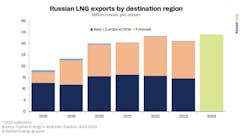Saudi Arabia unexpectedly halted its plans to increase crude production capacity by 1 million b/d to reach 13 million b/d, a target initially set in 2020. Aramco received the directive from the energy ministry Jan. 30, as stated in an investor press release.
Despite indicating its trajectory towards achieving the capacity goal by 2027 and investing billions to that end as recently as November 2023, the company has now postponed the investment. About the move, Saudi Energy Minister Prince Abdulaziz bin Salman was quoted as saying: “We have postponed this investment simply because we’re transitioning…Aramco has oil, it has gas. It will even have geothermal very soon.”
Since fourth-quarter 2022, Riyadh has been reducing output through additional voluntary OPEC+ cuts, responding to surging US production levels and robust growth from countries like Brazil and Guyana. Having collectively shut in nearly 2 million b/d of supply since third-quarter 2022, Saudi Arabia is currently pumping 9 million b/d of crude oil, marking the lowest level since 2011, excluding the COVID-affected period of 2020-21.
Global oil supply
Consequently, Saudi Arabia now holds over 3 million b/d of spare crude oil capacity, providing a supply buffer for the global oil market in case of severe disruptions. This sizable buffer diminishes the immediate pressure for Aramco to increase capacity beyond the current 12 million b/d (excluding the Neutral Zone shared between Saudi Arabia and Kuwait).
While Aramco has scaled back production, US shale production has surged, reaching record rates of 13.3 million b/d in fourth-quarter 2023. Production from the US, Brazil, Canada, and Guyana is projected to collectively contribute enough oil to meet global demand growth this year, according to the International Energy Agency (IEA).
Riyadh has committed to capping output at 9 million b/d until end-March, as part of broader voluntary OPEC+ cuts adopted by some members of the alliance. If it gradually phases out this reduction in second-quarter 2024, the Kingdom could potentially pump 9.65 million b/d of crude this year, aligning closely with the levels seen in 2023. This would leave Saudi Arabia with about 2.5 million b/d of spare capacity annually, exceeding the 2 million b/d average observed over the past 20 years.
“In the medium term, barring any unexpected disruptions, steadily slowing global oil demand growth and continued non-OPEC+ supply gains should ensure world oil markets remain adequately supplied – even with Saudi Arabia’s lower target for crude oil capacity down the road. That raises the question of when, or if, Aramco would need to reactivate its capacity expansion plan, especially given the cost of sustaining idle capacity,” IEA commented.
Failure to do so (reactivating its capacity expansion plan) could potentially leave Saudi Arabia with historically limited spare crude oil capacity by the end of the decade. According to IEA’s forecasts, Saudi crude supply is anticipated to steadily rise from 2025 onwards, reaching a record annual rate of 11.2 million b/d in 2028. In such a scenario, Riyadh would be left with only 1 million b/d of spare capacity annually, the lowest ever recorded.
However, total Saudi oil supply capacity, including condensates and natural gas liquids (NGLs), is projected to increase substantially in the medium term, primarily due to the anticipated commencement of operations at Jafurah, the Kingdom's largest unconventional non-oil associated gas field. As potentially the largest shale gas reserves globally outside of the US, Jafurah is expected to yield over 600,000 b/d of condensates and NGLs by 2030. Given the shifting focus of oil demand towards petrochemicals and light ends, the planned production increases from Jafurah align well with this evolving pattern, IEA said.

